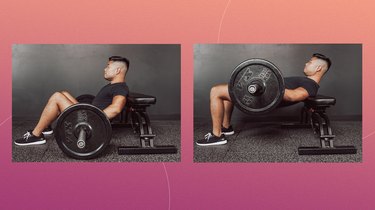
If you want to build your glutes, the hip thrust (HT) is the single best exercise you can do.
It gets your gluteal muscles working harder than virtually any other exercise, is simple to do, removes potential stress on your lower back and works for exercisers of all strength levels and ages. Seriously, what's not to like?
Video of the Day
Video of the Day
Consider this our ode to the magic of HTs. Plus, a primer on how to do the exercise for maximum hip thrust benefits.
How Hip Thrusts Rock Your Glutes
"The hip thrust [HT] is a fantastic hip extension exercise that primarily emphasizes the gluteus maximus," says Jason Pak, CPT, a certified personal trainer, USA Weightlifting–certified sports performance coach and co-owner of Achieve Fitness Boston. (The gluteus maximus is the largest muscle in the butt — and the body, for that matter.)
"It is a highly effective exercise at building the glutes because it loads the body with horizontal force, unlike most lower-body exercises, such as the squat, deadlift and lunge, which use vertical force," Pak explains. The horizontal force places constant resistance (aka tension) on your hips, whereas during vertical-force exercises, tension comes and goes depending on where you are in the movement.
Research backs this up. For example, a December 2015 study published in the Journal of Applied Biomechanics found that the barbell hip thrust activates the gluteus maximus and biceps femoris (the largest hamstring muscle) to a greater degree than the back squat. And when comparing the barbell and hex bar deadlift to the hip thrust, the HT provided the highest gluteus maximus activation, per a March 2018 study in the Journal of Strength and Conditioning Research.
But it's not just the horizontal force that makes the HT a prime glute move. The the locked-out position at the top of the thrust is an optimal position for building muscle. That's because the glutes work the hardest when they're maximally extended, Pak says.
3 More Hip Thrust Benefits
Wait, but that's not all. HTs have a few other benefits going for them.
1. They’re Great for All Fitness Levels
Thrusts may look like something only experienced lifters can do, but one of the benefits of hip thrusts is that they're good for exercisers of all levels, says Lisa Schroeder, CPT, a certified personal trainer at Life Time Chanhassen. Compared with deadlifts and squats, the HT requires less core stability, spinal extension strength, balance and coordination, she says.
That's also part of the reason the move really hones in on the glutes — you don't have to focus on core stability or other small technical details to make the exercise happen. The brunt of the work goes straight to your glutes.
And you can tailor the exercise to your current strength and comfort levels. Try doing the exercise with a dumbbell rather than a barbell to practice your form. Or use a light barbell. Your hips are the largest, strongest joint in your entire body, and thrusts isolate them. So you might be surprised how strong you already are at the movement.
To progress the hip exercise, simply add weight, slow down your tempo or add a pause at the top.
2. They’re Gentle On the Spine
Deadlifts and back squats are great glute exercises. But they do put some load on the spine. "This heightens the risk of abdominal hernia, disc injuries, wear and tear and many other potential injuries," Schroeder says.
Older adults and people with back issues may find that HTs are a fantastic way to train the lower body while minimizing stress and force on the lower back, Pak says. Plus, strengthening the glutes and hips, in general, takes pressure off the lower back, so it may help reduce pain in this area.
Related Reading
3. They've Got a Ton of Variations
Every week deserves (at least one) hip thrust. But, fortunately, that doesn't mean you have to move the exact same way in your glute workouts for weeks, months or even years to come. Instead, you can move from one hip thrust variation to the next.
While each trains your gluteal muscles, each also has its own unique set of hip thrust benefits. For example, doing a HT with a mini band around your thighs, just above your knees, hammers your glute medius in the top sides of your hips. A single-leg thrust (usually done with a single dumbbell) builds unilateral strength and works your core.
Once you've mastered the foundational move, choose the variation that fits your current needs and training goals.
How to Do Hip Thrusts
Here, Pak shows how to do hip thrusts with proper form. To reap the greatest hip thrust benefits, follow his lead.
Barbell Hip Thrust

- Sit on the floor with your mid back (mid to lower shoulder blades) against the edge of a bench or box.
- Keep your feet on the floor about hip-width apart. Your feet can be slightly turned out, depending on what feels comfortable for you.
- Place some sort of pad (towel, squat sponge, Hampton thick bar pad, Airex pad) on top of your pelvis.
- Roll the barbell to the top of the pad at your hip's crease. You can also have someone help place the barbell into position once you’re ready.
- Keeping your head facing forward and back straight, squeeze your glutes and push through your heels to lift your hips and the weight up toward the ceiling.
- Lock your hips out at the top of the movement by fully extending the hips and squeezing the glutes more while tucking the tailbone between your legs. Your shins should be vertical, knees neutral or slightly externally rotated and shins vertical.
- Pause. Then keeping a flat back, slowly lower your hips down to return to the starting position.
Related Reading
- Journal of Applied Biomechanics: "A Comparison of Gluteus Maximus, Biceps Femoris, and Vastus Lateralis Electromyographic Activity in the Back Squat and Barbell Hip Thrust Exercises"
- Journal of Strength and Conditioning Research: "Electromyographic Comparison of Barbell Deadlift, Hex Bar Deadlift, and Hip Thrust Exercises: A Cross-Over Study"